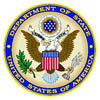| United States Embassy Tokyo, Japan |
 |
||
| Welcome to the U.S. Embassy in Tokyo. This site contains information on U.S. policy, public affairs, visas and consular services. |
|
|
||||||||||||||||||||||||||||||
|
But new technology will require more security features
Efforts to protect U.S. currency against international counterfeiting continue to be effective although advances in computer and reproduction technology will require ongoing and regular security enhancements, according to the U.S. Department of the Treasury.
A new report to Congress submitted jointly by Treasury and the Federal Reserve Board found that the incidence of counterfeiting of U.S. dollars is low, with approximately one counterfeit note per 10,000 worldwide, Treasury said in a March 14 news release.
The study concluded that counterfeiting of U.S. currency declined markedly following the introduction of re-designed notes in 1996 and will likely decline further with the expected introduction in 2003 of a new currency series with additional security features. Those features will, for the first time, include use of a color other than green on U.S. banknotes.
The report to Congress also details cooperative efforts by U.S. enforcement agencies and their overseas counterparts to combat global counterfeiting.
According to Treasury, overseas holdings of U.S currency ranged between $340,000 million and $370,000 million -- more than half of the roughly $620,000 million held outside of banks and other institutions in the last quarter of 2002.
The text of the report is available on the Treasury web site.
Following is the text of the news release
JOINT FEDERAL RESERVE AND TREASURY REPORT HIGHLIGHTS U.S. EFFORTS TO CONFRONT GLOBAL COUNTERFEITING
The Federal Reserve Board and the Treasury Department today issued a joint report to Congress stating that procedures to combat international counterfeiting of U.S. currency are becoming more effective.
U.S. dollars are held and widely used around the world, and the popularity and ubiquity of the dollar make it a potential target for counterfeiters. The incidence of counterfeiting has declined markedly with the introduction of the 1996-series currency. An upcoming new series currency, to be introduced later this year, will further enhance the security of U.S. banknotes.
The report, "The Use and Counterfeiting of United States Currency Abroad, Part II," mandated by Congress as part of the Anti-Terrorism and Effective Death Penalty Act of 1996, represents a comprehensive review of the international use and counterfeiting of U.S. currency. The report details how the combined efforts of the Treasury, United States Secret Service, and Federal Reserve have held the incidence of counterfeiting at relatively low nominal levels.
"We continue to improve our currency and resist efforts by counterfeiters the world over to produce and pass counterfeit U.S. notes," said Treasury Secretary John W. Snow. "Only by such efforts can we guarantee that our currency will continue to remain a symbol of American strength and stability."
"U.S. currency continues to hold an important place in the payment system at home and abroad and maintaining its integrity is of utmost concern to the Federal Reserve," said Roger Ferguson, Vice Chairman of the Board of Governors of the Federal Reserve System. "A secure currency precludes the need for businesses, merchants and the public to expend significant resources and time validating the genuineness of currency. When payment systems work well, the economy functions more efficiently."
This second report to the Congress on the use and counterfeiting of U.S. currency abroad provides further evidence that improved note designs have been more difficult for counterfeiters to copy. The result has been much smaller proportions of counterfeits of new design notes among notes processed at Federal Reserve Banks.
According to the report, efforts to protect U.S. currency continue to be effective. The incidence of counterfeiting is low, with approximately one counterfeit note per 10,000 notes worldwide. The United States Secret Service is working closely with overseas banks and law enforcement agencies to help suppress counterfeiting activities.
The report highlights important steps the U.S. Government is currently taking to combat global counterfeiting:
-- A Secret Service web site allows law enforcement agencies and currency handlers worldwide to report instances of counterfeiting and to learn more about the characteristics of a suspect note.
-- The Federal Reserve Bank of New York has established overseas cash depots at foreign commercial banks. These facilities allow overseas dollar users to obtain new U.S. currency more efficiently and increase the repatriation rate of worn and old-design U.S. currency.
-- U.S. enforcement agencies are working with their overseas counterparts to target cities and countries that first receive counterfeit notes in the wholesale distribution chain.
The study concludes that overseas holdings of U.S currency ranged between $340 billion and $370 billion out of the roughly $620 billion in U.S. currency held outside of U.S. depository institutions in the last quarter of 2002.
According to the report, advances in reprographic and computer technology will continue to necessitate new and innovative responses to maintain the overall security of U.S. currency. These efforts will include further security enhancements to the currency design, enhanced cooperation with international law enforcement agencies and additional training of foreign law enforcement, and financial officials in counterfeit detection.
This site is produced and maintained by the Public Affairs Section of the U.S. Embassy, Japan. Links to other Internet sites should not be construed as an endorsement of the views contained therein.